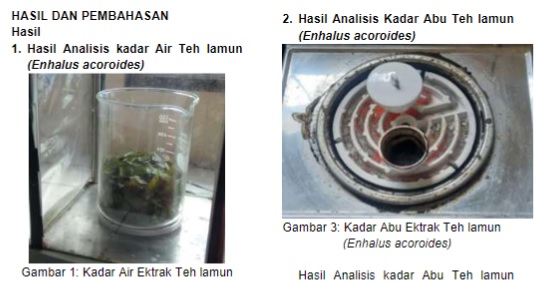ANALISIS KADAR AIR DAN KADAR ABU TEH BERBAHAN DASAR DAUN LAMUN ( Enhalus acoroides)
Abstract
Background: Seagrass is one of the components that make up this diversity. In addition to fruit and seeds, other parts of the seagrass plant, Enhalus acoroides, the opportunity to utilize seagrass as an alternative food base is very large and has the potential to be processed into innovative foods such as herbal teas.
Methods: Testing the Moisture Content by means of a porcelain cup dried in an oven at 105˚C for 3 hours, after that it was weighed, added as much as 100g of samples of Seagrass tea extract (Enhalus acoroides) and placed in an oven at 105˚C for 3 hours. The weight of the cup and sample was weighed. The ash content was tested in the same way, except that 1-2 g of the sample was used and then dried in an electric furnace at 600˚C for 18-24 hours. Samples that have become ash are weighed.
Results: The results of the analysis of the water content of seagrass tea (Enhalus acoroides) obtained the value of the water content of seagrass tea ranging from 9.17%-9.18%. The average value of the water content of seagrass tea is 9.17%. The results of the analysis of the ash content of seagrass tea (Enhalus acoroides) obtained that the water content of seagrass tea ranged from 18.52%-18.56%. The average value of the water content of seagrass tea is 18.53%.
Conclusion: From the data obtained, it can be concluded that the water content of Seagrass Tea (Enhalus acoroides) is 9.17% and the Ash content of Seagrass Tea (Enhalus acoroides) is 18.53%.
Downloads

Authors who publish with this Journal agree to the following terms:
- Author retain copyright and grant the journal right of first publication with the work simultaneously licensed under a creative commons attribution license that allow others to share the work within an acknowledgement of the work’s authorship and initial publication of this journal.
- Authors are able to enter into separate, additional contractual arrangement for the non-exclusive distribution of the journal’s published version of the work (e.g. acknowledgement of its initial publication in this journal).
- Authors are permitted and encouraged to post their work online (e.g. in institutional repositories or on their websites) prior to and during the submission process, as it can lead to productive exchanges, as well as earlier and greater citation of published works




 2
2






